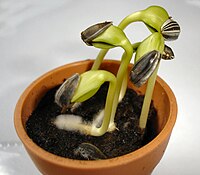
Photo from wikipedia
Abstract The Gram-positive, anaerobic, spore-forming bacterium, Clostridium perfringens (C. perfringens) causes a variety of diseases in humans and other animals. Spore germination is thought to be the first stage of… Click to show full abstract
Abstract The Gram-positive, anaerobic, spore-forming bacterium, Clostridium perfringens (C. perfringens) causes a variety of diseases in humans and other animals. Spore germination is thought to be the first stage of infection by C. perfringens. AGFK, a mixture of l -asparagine, d -glucose, d -fructose, and potassium ions, is an effective nutrient germinant. The objective of this study was to investigate the effects of different AGFK concentrations (0, 50, 100, 200 mM/mL) on C. perfringens spore germination. This paper proposes a novel rapid method for the measurement of spore germinability based on microscopic hyperspectral imaging technology (HSIT). The spore germination rate (Srate), the OD600% and Ca2+-DPA% of C. perfringens were determined by chemical methods under different concentrations of AGFK. The results showed that spores have a maximum germination rate of 94.59% after 80 min with 100 mM/mL AGFK. Microscopic HSIT revealed that the spectral and spatial characteristics of spores varied during the spore germination process. Multivariate analyses (GA-siPLS and GA-PLS) and the gray symbiotic matrix (GLCM) were used to extract highly correlated spectral and spatial descriptors from the time-series data from microscopic HSIT, respectively. Single spectral, spatial signals and data fusion of spectral and spatial information were then used to predict the Srate, the OD600% and Ca2+-DPA % by GA-PLS, respectively. The result show that the Srate calibration was built by GA-PLS using data fusion variables and yielded acceptable results (Rc = 0.96, RMSEC = 0.64, Rcv = 0.93, RMSEP = 0.87, Rp = 0.94). The OD600% optimal model was built by GA-PLS using image variables and yielded acceptable results (Rc = 0.93, RMSEC = 19.36, Rcv = 0.91, RMSEP = 24.36, Rp = 0.89). For Ca2+-DPA %, the model based on the fusion of spectral and imaging data was optimal. The Ca2+-DPA % calibration yielded acceptable results (Rc = 0.95, RMSEC = 49.83, Rcv = 0.93, RMSEP = 58.98, Rp = 0.92). This work demonstrates the potential of microscopic HSIT for the non-destructive detection of spore germinability. The data fusion models also significantly improved the prediction of spore germinability. In conclusion, microscopic HSIT exhibits considerable promise for nondestructive diagnostics of spore germination.
Journal Title: Journal of Food Engineering
Year Published: 2020
Link to full text (if available)
Share on Social Media: Sign Up to like & get
recommendations!